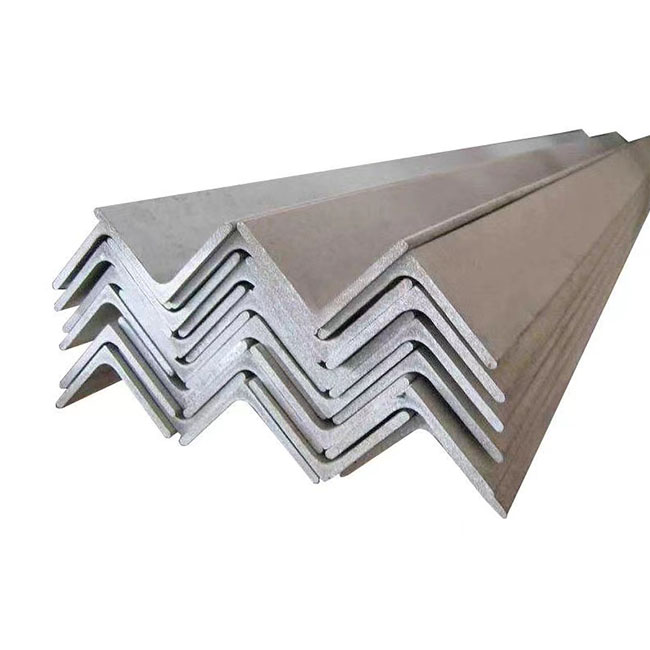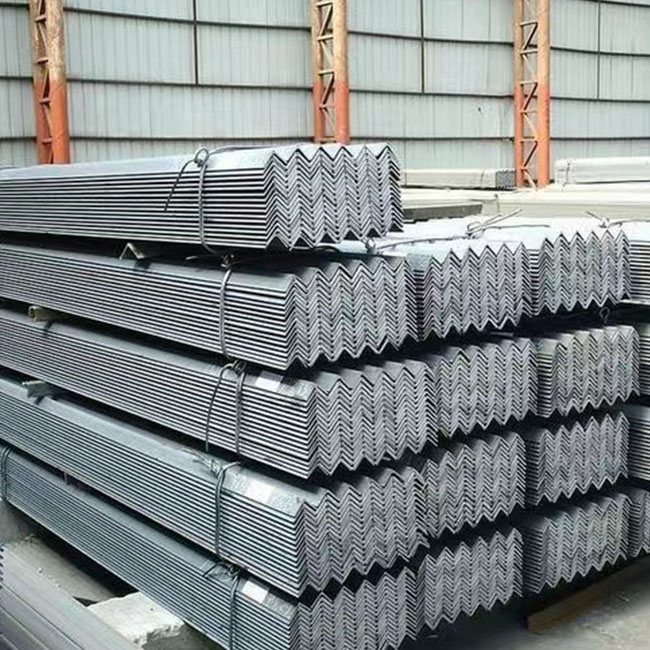Tel
+86-18837209569
- All
- Product Name
- Product Keyword
- Product Model
- Product Summary
- Product Description
- Multi Field Search
Views: 0 Author: Site Editor Publish Time: 2025-07-09 Origin: Site








Stainless steel angles are crucial components in engineering and design. They are widely used in various industries for structural support. But what exactly are stainless steel angles? These L-shaped profiles are made from durable materials and offer exceptional strength. In this article, we'll explore the properties, salient features, and key applications of stainless steel angles. You'll learn how these versatile components contribute to both functionality and aesthetics in construction and other sectors.
Stainless steel angles are typically made from iron, chromium, and nickel. These materials combine to form a strong, durable metal resistant to corrosion. The composition of stainless steel can vary depending on the grade. For example, 304 grade stainless steel contains around 18% chromium and 8% nickel, while other grades might include additional elements like molybdenum for extra corrosion resistance.
The specific combination of materials in stainless steel affects its strength, corrosion resistance, and overall performance, making it ideal for different applications.
Equal angles have legs of the same length, while unequal angles feature legs of different lengths. Equal angles are commonly used when uniformity is required in construction, such as in frames or supports. Unequal angles, on the other hand, are preferred in situations where extra strength is needed on one side, like in specific architectural or industrial applications.
Stainless steel angles have an L-shaped profile, formed by bending a single piece of stainless steel at a 90-degree angle. This simple yet strong structure provides stability and support in various applications.
The typical dimensions of stainless steel angles range from small sizes, like 20mm x 20mm, to larger ones, such as 200mm x 200mm. The thickness can vary from 2mm to 20mm, depending on the specific requirements of the project.

Stainless steel angles are highly durable. They can withstand heavy loads and resist wear and tear, making them ideal for structural support. Whether used in buildings or bridges, their ability to maintain strength over time is one of their biggest advantages.
One of the key features of stainless steel angles is their corrosion resistance. The chromium in the steel forms a protective layer, preventing rust even in harsh environments. This makes them perfect for outdoor use or in industries where exposure to chemicals and moisture is common.
Stainless steel angles are designed to handle high temperatures. This makes them suitable for use in environments like chemical plants or outdoor structures exposed to the sun. They maintain their integrity and strength even in extreme heat.
Stainless steel angles are sleek and modern. Their shiny surface and clean lines make them popular in architecture and interior design. Whether in commercial buildings or furniture, they add a stylish, contemporary look.
Stainless steel is non-porous, making it easy to clean. Dust and dirt don't stick to the surface, so a quick wipe with soapy water is enough. This is especially useful in environments like food processing or kitchens.
Stainless steel angles have high tensile strength. This means they can endure a lot of mechanical stress without breaking. It's one of the reasons they’re used for structural applications.
Yield strength refers to the amount of stress a stainless steel angle can bear before it starts to deform. Stainless steel angles are engineered to endure significant pressure, making them reliable for heavy-duty use.
Stainless steel angles come in several finishes. A brushed finish offers a soft texture, while a polished finish gives it a high shine. Matte finishes provide a smooth, understated look. These finishes not only affect appearance but also influence corrosion resistance and cleaning ease.
Stainless steel angles are produced using various methods, each chosen based on the specific requirements of the project. The main processes include hot rolling, cold rolling, cold drawing, and laser fusion. Each method affects the final product's characteristics, such as strength, finish, and precision. Let's dive into how each one works.
Hot rolling is the most common method for manufacturing stainless steel angles. The process involves heating the steel above its recrystallization temperature, then passing it through rollers to shape it into an L-profile. Hot rolling is cost-effective and ideal for large-scale production. It's typically used for angles that don't require precise dimensions but need to be produced in large quantities. The steel's surface is often slightly rough due to the process, but it offers excellent mechanical strength.
Cold rolling is used to refine the surface and improve the dimensions of the stainless steel angles. In this process, the steel is passed through rollers at room temperature. Cold rolling results in a smoother finish, tighter tolerances, and enhanced strength. The angles produced have a polished appearance, making them ideal for architectural and decorative applications where appearance matters just as much as performance. The process also improves the overall accuracy of the angles' dimensions.
Cold drawing is a process where the steel is pulled through a die to achieve a precise shape and size. This method is perfect for creating angles with sharp edges and exact measurements. Cold drawing gives the angles better precision, making them suitable for applications where tight tolerances are critical.
Laser fusion, on the other hand, involves welding two flat stainless steel plates together using a laser to form an L-profile. This process is excellent for producing customized profiles with clean, sharp edges. It's ideal for special projects requiring unique shapes or profiles that cannot be achieved with other methods.
Stainless steel angles come in various sizes to meet different project requirements. Standard sizes range from small 20mm x 20mm angles to larger 200mm x 200mm bars, with thicknesses typically between 2mm and 20mm. However, many projects require customization. Manufacturers can tailor the size, shape, and finish of stainless steel angles to suit specific needs.
Customization allows manufacturers to adjust the angles' dimensions, surface finish, and even the type of steel used. This flexibility ensures that stainless steel angles meet the unique demands of any project, from large structural supports to smaller decorative applications.

Stainless steel angles are incredibly versatile. Whether for structural use or aesthetic purposes, they adapt to a wide variety of applications. From supporting heavy frameworks to creating intricate designs in architecture, stainless steel angles can be used in many ways. Their L-shaped profile can fit into almost any design requirement, offering endless possibilities in both commercial and residential projects.
One of the main advantages of stainless steel angles is their long lifespan. They are highly resistant to corrosion, rust, and environmental wear, making them ideal for outdoor and industrial applications. Once installed, stainless steel angles require little maintenance. Their strength and durability mean they continue to perform well over many years, saving money on repairs and replacements.
Stainless steel is fully recyclable, making it an environmentally friendly choice. When stainless steel angles reach the end of their useful life, they can be melted down and reused to create new products. This reduces waste and minimizes the demand for raw materials. By choosing stainless steel, industries can contribute to sustainable practices and reduce their overall carbon footprint.
In addition to being functional, stainless steel angles bring aesthetic value to projects. Their clean, shiny finish and modern look are highly sought after in design-driven applications. Whether used in building facades, railings, or furniture, stainless steel angles add a sleek, contemporary touch. Their versatility in both design and function makes them a favorite in architectural and interior design projects.

Stainless steel angles are found in many industries due to their strength, durability, and versatility. From construction to automotive, their ability to withstand harsh conditions makes them suitable for a wide range of applications. Whether it's for structural support or aesthetic design, stainless steel angles play a vital role in various sectors.
In the construction and architecture industries, stainless steel angles are widely used for framing and structural support. They are essential in building frameworks, providing stability and strength. Additionally, their sleek, modern appearance makes them popular in architectural designs for both functional and decorative purposes. Stainless steel angles are often used for window frames, door frames, and support beams in skyscrapers and residential buildings.
Stainless steel angles are crucial in marine and chemical industries due to their corrosion-resistant properties. In the marine environment, where metal parts are constantly exposed to saltwater, stainless steel angles provide durability and protection against rust and corrosion. Similarly, in chemical plants, stainless steel angles are used for structural components exposed to harsh chemicals. Their resistance to rust ensures longevity in challenging environments.
In food processing and pharmaceuticals, hygiene is key, and stainless steel is the material of choice. Its non-porous, smooth surface makes it easy to clean, preventing the buildup of bacteria or contaminants. Stainless steel angles are used for equipment frames, shelving, and support structures in factories and laboratories, ensuring high standards of cleanliness and safety.
In the automotive sector, stainless steel angles are used for structural components such as brackets and frames, providing strength while remaining lightweight. These components are critical for the durability and safety of vehicles. In home appliances, stainless steel angles are used in various parts like refrigerator frames, washing machine supports, and oven components, offering long-lasting performance and resistance to wear and tear.
Stainless steel angles are widely used in renewable energy installations, such as wind and solar power systems. Their strength and ability to withstand outdoor conditions make them ideal for supporting solar panels and wind turbines. In heavy machinery, stainless steel angles are used to build durable and reliable structures, including frameworks and supports that need to bear large amounts of weight and stress.
Stainless steel angles are increasingly used in modern furniture and interior design. Their clean, polished finish adds a touch of elegance to any space. From custom shelving units to industrial-style tables and chairs, stainless steel angles provide both strength and style. They are perfect for creating sleek, contemporary designs in both residential and commercial interiors.
Stainless steel angles are highly valued for their durability, strength, and modern aesthetic appeal. They are versatile and widely used in industries like construction, marine, automotive, and more. Their ability to withstand harsh conditions while adding a sleek look makes them ideal for a variety of projects.
Choosing the right grade and manufacturing method ensures that your stainless steel angles meet the demands of your specific project. Welcome to Anyang Feiyue Consulting Products!
A: Equal stainless steel angles have two legs of the same length, while unequal angles have legs of different lengths. Equal angles are commonly used for uniform construction support, while unequal angles are used when additional strength is required on one side.
A: Grade 304 stainless steel is ideal for general use due to its strength and corrosion resistance. For marine applications or environments with high exposure to chemicals, 316 stainless steel is preferred due to its enhanced resistance to corrosion.
A: Yes, stainless steel angles can be customized in terms of size, thickness, and surface finish. Options include brushed, polished, or matte finishes. Custom profiles can also be created using techniques like cold drawing or laser fusion.
A: The cost of stainless steel angles is influenced by raw material prices (like chromium and nickel), production methods (hot or cold rolling), and market demand. Global economic conditions, supply chain disruptions, and energy costs can also impact the price.
Home | Products | Advantages | Application | Case | Company | Blog | Contact Us | Ferro Alloy | Steel | Refractory Material | Knowledge